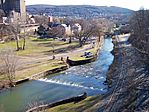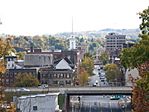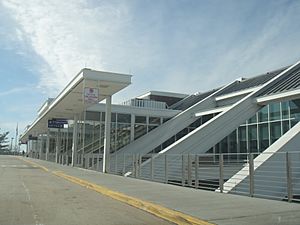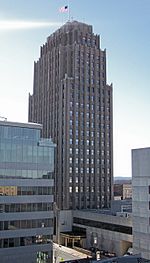Lehigh Valley facts for kids
Quick facts for kids
Lehigh Valley
Allentown–Bethlehem–Easton,
PA–NJ Metropolitan Statistical Area |
|
|---|---|
|
Eastern Pennsylvania
Metropolitan Statistical Area |
|

Map of the Lehigh Valley
|
|
| Country | United States |
| States | Pennsylvania New Jersey |
| Largest city | Allentown |
| Other cities |
List
|
| Rank | 74th |
| Elevation | 2,180 ft (660 m) |
| Population
(2020 U.S. Census)
|
|
| • Total | 861,889 |
| Time zone | UTC−5 (ET) |
| • Summer (DST) | UTC−4 (EDT) |
| Area code(s) | 570, 610 & 484, 908 |
The Lehigh Valley, known officially by the United States Census Bureau and the U.S. Office of Management and Budget as the Allentown–Bethlehem–Easton, PA-NJ Metropolitan Statistical Area and referred to colloquially as The Valley, is a metropolitan region officially consisting of Carbon, Lehigh, and Northampton counties in eastern Pennsylvania and Warren County in northwestern New Jersey. The Lehigh Valley's largest city is Allentown with a population of 125,845 residents as of the 2020 census.
The Lehigh Valley is Pennsylvania's third most populous metropolitan area, surpassed only by the Philadelphia and Pittsburgh metropolitan areas in total population, and the 68th largest metropolitan area in the nation with a population of 861,889 residents as of the 2020 U.S. Census. The Valley's population has grown 4.95% since the 2010 U.S. census. Lehigh County, the Valley's largest county in terms of overall population, is among the fastest-growing counties in the state. The Lehigh Valley leads the state of Pennsylvania in terms of population growth in the 18-to-34 year old demographic according to 2020 Census data. The Lehigh Valley's core population centers are located in southern and central Lehigh and Northampton counties along U.S. Route 22, Pennsylvania Route 309, Interstate 476, and Interstate 78.
The Lehigh Valley is centrally located in the Northeast megalopolis with ease of access and close proximity to several of the largest markets, population centers, airports, terminals, railways and seaports, including New York City, which is 65 miles (105 km) to its east, and Philadelphia, which is 50 miles (80 km) to its southeast. The region is situated within a one-day drive to more than a third of the total population of the United States and more than half of the total population of Canada, which has made it an appealing location for warehousing, logistics, manufacturing, e-commerce, and distribution industries. The region is serviced by air by Lehigh Valley International Airport, which has experienced steady growth in passenger traffic and rapid growth in the transportation of air cargo, flying more than 210 million pounds of cargo annually. The Lehigh Valley played a central role in the American Industrial Revolution and subsequently was a global leader in heavy manufacturing advancements, contributing to the rise of the U.S. as a global industrial power from the mid-18th through the late 20th centuries.
The Lehigh Valley's total gross domestic product (GDP) in 2017 was US$43,800,000,000 ($43.8 billion), driven heavily by manufacturing, health care, finance, and professional services industry components. It is one of the largest and fastest growing economies in Pennsylvania with a 5% increase in GDP between 2016 and 2017 alone. The median household income for the region increased from US$57,288 to US$62,507 between 2015 and 2019. The Lehigh Valley economy includes advanced manufacturers, especially those in life sciences, that have driven the region to become the nation’s 52nd largest manufacturing economy and made it among the nation’s busiest industrial markets, according to 2020 Census data.
Within the Lehigh Valley, Lehigh and Northampton Counties are part of Philadelphia's designated media market, Warren County is part of New York City's media market, and Carbon County belongs to the Wilkes-Barre–Scranton–Hazleton media market.
Contents
Historical region
The Lehigh Valley is named for the Lehigh River, which runs through it, and owes much of its development and history to the anthracite supplies, timber, and ores which poured down the Lehigh Coal & Navigation Company's (LC&N) Lehigh Canal and railroads LC&N built or encouraged parallel to it. The lower Lehigh Valley is geologically part of the Great Appalachian Valley and is bordered on the north by the mineral-rich Ridge and Valley Appalachians, which define its rugged upper parts from ‹See Tfd›White Haven and west of the Poconos, south through the Lehigh Gorge to the Lehigh Gap near ‹See Tfd›Palmerton. The upper drainage basin contains or shares nearly half the southeastern Coal Region, which have the richest anthracite deposits in the world, while the lower valley holds valuable limestone, sandstone, and clay deposits. In the charter of March 20, 1818 for the Lehigh Navigation Company, the legislature gave virtual total control to the Canal Company which it retained until 1964. These transportation improvements overcame the country's first energy crises due to deforestation in the early 19th century. The Canal operated into the Great Depression, feeding ports up and down the Delaware River, the Delaware Canal, and transoceanic demand, and was integral to the regional industrial revolution in the greater Philadelphia-Trenton-Wilmington region. The Morris Canal and the 22–23 miles (35–37 km) coal feeder of the Delaware and Raritan Canal and locks at ‹See Tfd›New Hope on the Delaware Canal were built to fuel the anthracite needs of Newark, Trenton, Jersey City and New York City.
Consequently, culturally and historically, the Valley runs from the drainage divide in the Solomon Gap just north of Mountain Top where coal flowed up the Ashley Planes from the Wyoming Valley coal beds in Luzerne County and across the divide, then downhill to the White Haven, then down through the Lehigh Gorge, past the historic Jim Thorpe terminus of the Summit Hill & Mauch Chunk Railroad (SH&MC) through historic locks and dams below Jim Thorpe or along side the canal which fueled the American Industrial Revolution and operated into the Great Depression. The American Canal age had its epicenter at the confluence of the Lehigh and Delaware rivers where five major canals met major rivers and coastal waterways, and all gave the people and industries of the Lehigh Valley access to minerals and markets via Easton from Connecticut, New York, Delaware, New Jersey, and Pennsylvania.
Cities and location
The Lehigh Valley's principal cities are Allentown, Bethlehem and Easton, making up the Allentown-Bethlehem-Easton metropolitan area. The traditional bounds of the region are The Poconos to the north, the Delaware River to the east, the boundaries of Berks County and Montgomery County to the southwest, and the boundary with Bucks County to the south. More recently, however, the area around Phillipsburg, New Jersey west of Pohatcong Mountain, parts of upper Bucks County around Quakertown, and portions of northeastern Berks County and southern Carbon and Schuylkill counties in Pennsylvania are considered outer parts of the Valley.
The Lehigh Valley is located approximately 60 mi (97 km) north of Philadelphia, 80 mi (130 km) northeast of Harrisburg, and 90 mi (140 km) west of New York City, the country's largest city. The area is home to more than 820,000 people as of the 2010 U.S. Census. Recent census studies show it to be the fastest growing region in Pennsylvania, due in part to its growing popularity as a bedroom community for the highly populated neighboring regions of Philadelphia, New Jersey and New York City as well as its favorable business climate and much lower cost of living in comparison to surrounding areas.
The Lehigh Valley is geologically and geographically part of the Great Appalachian Valley, a region largely made up of limestone that stretches along the eastern edge of the Appalachian Mountains. The Lehigh Valley is so named because it is composed of an actual valley that lies between two mountain ranges, Blue Mountain to the north and South Mountain to the south. Lehigh Valley also is considered part of the historic Pennsylvania Dutch Country.
Municipalities with more than 10,000 people
|
|
Municipalities with fewer than 10,000 people
Census-designated places and villages
Metropolitan and Combined Statistical Areas
The United States Office of Management and Budget has designated the Lehigh Valley area of Pennsylvania as the Allentown–Bethlehem–Easton, PA Metropolitan Statistical Area. The three counties in the Metropolitan area are Carbon, Lehigh and Northampton. As of the 2010 United States Census the Metro area had a population of 821,173. The Lehigh Valley ranks as the third most populous metropolitan areas in the state of Pennsylvania and ranks 68th most populous in the United States.
The United States Office of Management and Budget also has designated the Lehigh Valley area of Pennsylvania as part of the larger New York metropolitan area. The larger combined area consists of the Lehigh Valley counties of Carbon, Lehigh and Northampton as well as Pike County and the Monroe County/East Stroudsburg, PA Metropolitan Statistical Areas in Pennsylvania, and several other Metro areas from the States of New Jersey and New York. As of the 2010 US Census, the population of the CSA was 23,076,664, making it the most populous Combined Statistical Area in the United States.
Climate
The Lehigh Valley has four distinct seasons, which typically include humid summers, cold winters, and very short and mild springs and falls.
| Climate data for Allentown, Pennsylvania (Lehigh Valley Int'l), 1981–2010 normals, extremes 1922–present | |||||||||||||
|---|---|---|---|---|---|---|---|---|---|---|---|---|---|
| Month | Jan | Feb | Mar | Apr | May | Jun | Jul | Aug | Sep | Oct | Nov | Dec | Year |
| Record high °F (°C) | 72 (22) |
77 (25) |
87 (31) |
93 (34) |
97 (36) |
100 (38) |
105 (41) |
100 (38) |
99 (37) |
92 (33) |
81 (27) |
72 (22) |
105 (41) |
| Mean maximum °F (°C) | 57.9 (14.4) |
59.6 (15.3) |
71.6 (22.0) |
82.5 (28.1) |
88.2 (31.2) |
91.9 (33.3) |
94.2 (34.6) |
92.5 (33.6) |
88.0 (31.1) |
79.0 (26.1) |
70.6 (21.4) |
59.7 (15.4) |
95.4 (35.2) |
| Average high °F (°C) | 36.0 (2.2) |
39.8 (4.3) |
49.4 (9.7) |
61.3 (16.3) |
71.5 (21.9) |
80.1 (26.7) |
84.2 (29.0) |
82.4 (28.0) |
74.9 (23.8) |
63.6 (17.6) |
52.5 (11.4) |
40.5 (4.7) |
61.4 (16.3) |
| Average low °F (°C) | 19.5 (−6.9) |
21.7 (−5.7) |
28.8 (−1.8) |
38.5 (3.6) |
48.3 (9.1) |
58.1 (14.5) |
62.7 (17.1) |
60.9 (16.1) |
52.9 (11.6) |
41.3 (5.2) |
32.9 (0.5) |
24.0 (−4.4) |
40.8 (4.9) |
| Mean minimum °F (°C) | 3.0 (−16.1) |
5.7 (−14.6) |
13.1 (−10.5) |
26.0 (−3.3) |
35.5 (1.9) |
46.3 (7.9) |
52.6 (11.4) |
49.8 (9.9) |
39.2 (4.0) |
28.8 (−1.8) |
19.9 (−6.7) |
9.1 (−12.7) |
0.2 (−17.7) |
| Record low °F (°C) | −15 (−26) |
−12 (−24) |
−5 (−21) |
12 (−11) |
28 (−2) |
39 (4) |
46 (8) |
41 (5) |
30 (−1) |
21 (−6) |
3 (−16) |
−8 (−22) |
−15 (−26) |
| Average precipitation inches (mm) | 3.03 (77) |
2.70 (69) |
3.39 (86) |
3.56 (90) |
4.14 (105) |
4.31 (109) |
4.95 (126) |
3.69 (94) |
4.62 (117) |
3.88 (99) |
3.50 (89) |
3.58 (91) |
45.35 (1,152) |
| Average snowfall inches (cm) | 10.0 (25) |
11.1 (28) |
4.9 (12) |
1.0 (2.5) |
0 (0) |
0 (0) |
0 (0) |
0 (0) |
0 (0) |
0 (0) |
0.7 (1.8) |
5.2 (13) |
32.9 (84) |
| Average precipitation days (≥ 0.01 in) | 11.1 | 9.8 | 11.0 | 12.1 | 12.1 | 11.4 | 10.9 | 9.5 | 9.1 | 9.1 | 9.8 | 10.9 | 126.8 |
| Average snowy days (≥ 0.1 in) | 5.6 | 4.8 | 2.5 | 0.4 | 0 | 0 | 0 | 0 | 0 | 0 | 0.6 | 3.5 | 17.4 |
| Average relative humidity (%) | 69.1 | 66.7 | 62.6 | 60.9 | 65.6 | 67.9 | 68.8 | 71.9 | 74.0 | 71.8 | 70.5 | 71.4 | 68.4 |
| Source: NOAA (relative humidity 1961–1990) | |||||||||||||
Demographics
| Historical population | |||
|---|---|---|---|
| Census | Pop. | %± | |
| 1900 | 231,341 | — | |
| 1910 | 289,686 | 25.2% | |
| 1920 | 346,664 | 19.7% | |
| 1930 | 391,516 | 12.9% | |
| 1940 | 396,673 | 1.3% | |
| 1950 | 437,824 | 10.4% | |
| 1960 | 545,057 | 24.5% | |
| 1970 | 594,124 | 9.0% | |
| 1980 | 635,481 | 7.0% | |
| 1990 | 686,688 | 8.1% | |
| 2000 | 740,395 | 7.8% | |
| 2010 | 821,623 | 11.0% | |
| 2020 | 861,889 | 4.9% | |
The Lehigh Valley has a total population of 861,889 residents as of the 2020 U.S. Census, making it the third largest metropolitan area in Pennsylvania and the 68th largest such area in the nation.
According to the 2018 American Community Survey conducted by the U.S. Census Bureau, 87.1% of the population was White American, 4.6% were Black or African American, 0.1% were American Indian, 2.3% were Asian American, Native Hawaiian and Pacific Islander Americans made up 0.1%, 4.3% were of some other race, and 1.5% belonged to two or more races. Hispanics and Latinos of any race made up 11.3% of the population. Hispanics of any race made up the fastest-growing demographic in the Lehigh Valley. Lehigh County is in the top 1% of all U.S. counties for inward migration from international locations, according to a Select USA, a program of the U.S. Commerce Department. The Lehigh Valley as a whole also leads the state of Pennsylvania in terms of population growth in the 18-to-34 year old demographic, according to 2020 Census data.
The Lehigh Valley is seeing an influx of residents coming from New Jersey and New York to take advantage of the greatly reduced cost of living, employment opportunities, and close proximity to two of the largest cities in the country, Philadelphia and New York City. The population of the area is expected to increase by 227,000 people by 2040, making it one of the fastest-growing areas in the state and country.
The median household income in the Lehigh Valley is US$62,507 as of 2019 and it has seen significant increases in recent years as the area continues to grow and attract new businesses to the region.
In the 2000 Census, Carbon, Lehigh, and Northampton counties had a combined total of 223 Japan-born residents, and in 2007 of The Morning Call wrote that due to the establishments of Japanese businesses in the area, the number of such residents by then was higher.
Arts
The Allentown Art Museum, based in center city Allentown, is the Lehigh Valley's largest museum. The museum's collection includes more than 11,000 works of art. Lehigh University's Zoellner Arts Center and Lafayette College's smaller Williams Center for the Arts host a wide variety of plays, concerts and performances throughout the year.
Bethlehem is also home to ArtsQuest, a non-profit that promotes Visual and Performing Arts in the Lehigh Valley. The ArtsQuest center and Steelstacks campus on the site of the former Bethlehem Steel Company have several performing arts venues including the Levitt Pavilion and the Musikfest Cafe. The Banana Factory in Southside Bethlehem has several art studios and galleries open to the public.
Artsquest also hosts Musikfest every year in August. Musikfest is the largest free music festival in the country, bringing more than 1 million people to the region annually.
Recreation
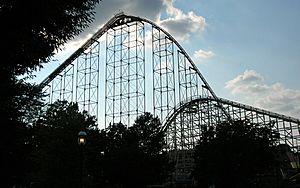
The Lehigh Valley is home to Dorney Park & Wildwater Kingdom, a popular amusement and water park. Located in South Whitehall Township, Dorney Park is known nationally for its elaborate roller coasters and water rides.
The region's ski resorts are Bear Creek Ski and Recreation Area and Blue Mountain Ski Area. Bear Creek is a 21 slope resort located outside of Macungie, Pennsylvania. Blue Mountain is located near Danielsville, Pennsylvania. The Poconos, which feature some of the East Coast's best-known ski resorts, is approximately 30 miles (48 km) north of the Lehigh Valley. Several large lakes used for boating and fishing also are located there. Pocono Raceway in the Poconos holds two NASCAR race weekends a year along with an IndyCar race. The region also hosts some of the best hiking in eastern Pennsylvania, including 30 miles of trails at the Trexler Nature Preserve.
New Jersey shore beaches are approximately 70 to 140 miles (110 to 230 km) to the east and southeast of the Lehigh Valley.
Dutch Springs, the nation's largest SCUBA amusement park, is in Bethlehem and Lower Nazareth Township. Over 40,000 divers annually utilize the facilities, which have sunken "treasures" to enhance the underwater experience. In addition to scuba diving, kayaking and paddle boats are available. The facility has a water park, camping grounds, and picnic areas.
In 2009, Sands Casino Resort Bethlehem, an $879 million casino, hotel and apartment complex owned by the Las Vegas Sands, opened in Bethlehem, bringing legalized gambling to the Lehigh Valley for the first time. It is one of only 13 authorized gaming sites in Pennsylvania.
Many large festivals are held each year in the Lehigh Valley. Musikfest, a large, 10-day music festival, is held in Bethlehem each August. Mayfair Festival of the Arts, a visual and performing arts festival, is held in the Allentown Fairgrounds each May. In September, one of the largest Celtic heritage festivals in America, The Celtic Classic, is held in Bethlehem. The Great Allentown Fair has been held on the grounds of the Allentown Fairgrounds in Allentown annually in late August through early September for more than 150 years. Das Awkscht Fescht is an antique car festival that is held annually the beginning of August in Macungie's Memorial Park.
Ice skating (including ice hockey, figure skating and speed skating) is popular in the Lehigh Valley and the region has three facilities. The Steel Ice Center is the premier ice skating facility, in Bethlehem on East 1st Street, not far from the Sands Casino. The Rink, formerly Lehigh Valley Ice Arena, is in Whitehall (north of Allentown) just off MacArthur Road (Route 145) on 7th Street. Each facility has two ice surfaces and public skate times are available at both facilities. The City of Bethlehem also opens a covered outdoor rink (one ice surface) annually from November through March.
The Bethlehem Skateplaza is a city park for skateboarding and freestyle BMX riding located at 1325 Steel Avenue, in Bethlehem.
Transportation
Air transportation
The Lehigh Valley's primary airport is Lehigh Valley International Airport (IATA: ABE, ICAO: KABE), located in Hanover Township, three miles (5 km) northeast of Allentown. The airport was utilized by 911,970 passengers in 2019, which represents an increase of 15.01% over its use the previous year, in 2018. Much of this growth has been driven by Allegiant Air's expansion at the airport.
Amazon.com utilizes Lehigh Valley International Airport as one of only 11 locations in the country for their Prime Air shipping service. LVIA was one of the first airports selected for the pilot concept of the program due to its close proximity to large population centers, cost effectiveness, robust infrastructure, and comparative ease of use. This location now ships more merchandise, has more flights, and serves more people (over 75 million from Boston to Washington, D.C. as of late 2016) for Amazon than any other facility in the country. Both Amazon and Lehigh Valley International continue to invest heavily in the local area to better support the ever-increasing demand for air cargo driven in large part by the explosion of e-commerce and the need for faster, more efficient delivery of merchandise. LVIA has seen rapid growth in the transportation of air cargo; as of 2020, it flew more than 210 million pounds of cargo annually with an increase of nearly 166% in tonnage shipped between 2015 and 2016 alone.
Due to the same aforementioned reasons for Amazon increasing its operations at the airport, FedEx Ground selected an area near LVIA to construct its largest terminal in the country. Companies such as Amazon.com and FedEx Ground are increasingly using the airport for these purposes, which is a major factor in Lehigh Valley International's growth.
The Valley is also served by Allentown Queen City Municipal Airport, a two-runway general aviation facility located off Allentown's Lehigh Street. Queen City is used predominantly by private aviation. Other general-aviation airports include Braden Airpark (also owned by the Lehigh-Northampton Airport Authority) in Easton, Hackettstown Airport in eastern Warren County, New Jersey, and Jake Arner Memorial Airport in Lehighton.
Bus transportation
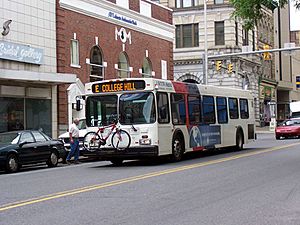
Public bus service in Lehigh Valley is available through the Lehigh and Northampton Transportation Authority, known as LANTA. In New Jersey, bus service is provided by NJ Transit including to Centre Square in Easton. Carbon County Community Transit provides service within Carbon County, to the Tamaqua area, and to the Lehigh Valley Mall via Walnutport.
The Lehigh Valley's inter-city bus links are to New York City, Reading, and Harrisburg, served by Klein Transportation, Fullington Trailways, Greyhound Lines, and Trans-Bridge Lines. The region has direct bus service to Philadelphia via OurBus. Martz Trailways stops in Allentown and at the Pocono interchange of Interstate 476 with service to Scranton via Wilkes-Barre and to Philadelphia. This is an Amtrak Thruway Motorcoach route connecting to Amtrak at 30th Street Station in Philadelphia. Chinatown bus lines operates multiple roundtrip bus lines daily between Manhattan and the Wind Creek Bethlehem casino in Bethlehem; more than 3,000 passengers use this service daily as of 2014.
Rail
The Norfolk Southern Railway (owned by the Norfolk Southern Corporation), is the Lehigh Valley's major rail operator. Norfolk Southern Railway uses the former Lehigh Valley Railroad's main line, the Lehigh Line and also uses a former Reading Railroad branch line, the Reading Line. Norfolk Southern Railway has major classification rail yards in Allentown and Bethlehem.
Unlike similarly-sized metropolitan regions, the Lehigh Valley has very limited passenger rail service. Only Hackettstown, in far eastern Warren County, sees regular passenger railway service. Around the Valley, passenger rail only gets as close as Doylestown and Annandale, both about 30 miles away. The closest Amtrak station to Allentown is Bryn Mawr, about 41 miles to the south. The rail hubs of 30th Street Station in Philadelphia and Newark are not much further, and provide the bulk of further intercity traffic from the Lehigh Valley.
Passenger service to Allentown and Bethlehem ceased in 1981 when several rail operators opted to curtail long-distance services. From the south, SEPTA Regional Rail limited their services to their electrified-only territory with trains going only as far north as Lansdale and Doylestown, Pennsylvania. (In the early and mid twentieth century golden age of passenger rail, the Reading Railroad provided rail service south and west of the area.) To the east, the Central Railroad of New Jersey ceased passenger operations into the area, from Jersey City, New Jersey, in 1967 in conjunction with the Aldene Connection.
The Lehigh Valley Railroad, primarily using its main line, served the areas with freight transporting along with the Lehigh & Hudson River Railway and the Lehigh & New England Railroad. In 1974, passenger service was restored to Phillipsburg under state (New Jersey) subsidy. That service was terminated in 1984. All of the original railroads ultimately went bankrupt and were taken over by today's railroads. SEPTA removed the tracks approaching Allentown and Bethlehem from the south. The nearest rail station for travel south towards Philadelphia is in Lansdale, Pennsylvania on SEPTA's Lansdale/Doylestown Line. The nearest station for travel eastward is High Bridge, New Jersey on New Jersey Transit Rail Operations's Raritan Valley Line.
Current operator New Jersey Transit has looked at restoring rail service to Phillipsburg, New Jersey, but there are no official plans to extend service over the border into Pennsylvania at present. Nor are there official plans to restore SEPTA service to Philadelphia. Freight operator Norfolk Southern Railway, heavily serves the region with a major classification yards in Allentown and Bethlehem using the former Lehigh Valley Railroad main line and the former Reading Company branch line, the Lehigh Line and the Reading Line. Canadian Pacific Railway, another freight operator, also transports through the Lehigh Valley using the Lehigh Line and the Reading Line.
In November 2008, the Lehigh Valley Economic Development Corporation (LVEDC), along with both Lehigh and Northampton Counties, commissioned a study to explore the merits of expanding New Jersey Transit rail to the Lehigh Valley, which would potentially include stops in Allentown, Bethlehem and Easton. The Lehigh Valley is currently the largest metropolitan area by population on the East Coast of the United States without passenger rail service of any kind. If plan succeeds, the Lehigh Line will then once again host passenger services for the first time since 1961.
Roads
The Lehigh Valley has four major highways: Interstate 78, a major east-west highway, runs through the southern part of the Valley, duplexed with Pennsylvania Route 309. I-78 runs from Lebanon County in the west, where Interstate 81 provides a connection to Harrisburg, to the Holland Tunnel and New York City in the east.
U.S. Route 22 is a major freeway that runs through the Valley from Kuhnsville in the western part of the Valley to Easton in the eastern part of the Valley. U.S. Route 22 starts in Cincinnati, Ohio in the west, running through the Valley to Newark, New Jersey in the east. A third highway, Pennsylvania Route 33, runs north-south through the Lehigh Valley, from the Poconos in the north to Northampton County in the south.
The fourth major highway in the Valley is Interstate 476, the Northeast Extension of the Pennsylvania Turnpike. It stretches 131 miles (211 km) from Chester in the south to the Scranton–Wilkes Barre area in the north.
Other major roads in the Valley include MacArthur Road (PA 145), a divided local road that leads to the Lehigh Valley Mall and its surrounding commercial district. Cedar Crest Boulevard, a north-south highway, runs from North Whitehall Township in the north through west-side Allentown to Emmaus in the south. Lehigh Street runs from northeast to southwest, originating in downtown Allentown and ending in Emmaus. Tilghman Street runs from Fogelsville in the west to continue as Union Boulevard into Bethlehem in the east. Tilghman Street runs through most of Allentown and also intersects with Cedar Crest Boulevard, Pennsylvania Route 100, Pennsylvania Route 309 and several other major Lehigh Valley highways.
Telecommunications
The Lehigh Valley area was once served only by the 215 area code from 1947 (when the North American Numbering Plan of the Bell System went into effect) until 1994. With the region's growing population, however, Lehigh Valley areas were afforded area code 610 in 1994. Today, the Lehigh Valley is covered by 610. An overlay area code, 484, was added to the 610 service area in 1999. A plan to introduce area code 835 as an additional overlay was rescinded in 2001.
Economy
The Lehigh Valley's current economy is unusually well balanced and multi-faceted compared to national averages and very different from the 20th century when it was based heavily on manufacturing, apparel, and the steel production. As of 2019, the top five industries in the region are 1.) finance, 2.) manufacturing, 3.) education, 4.) professional services, and 5.) health care. Other major industry sectors in the area include retail, transportation and warehousing, arts and entertainment, and information services. All of the top five largest industry sectors are fairly equally balanced in their contribution to the area's total Gross Domestic Product (GDP) of US$43,800,000,000 ($43.8 billion) as of 2017.
History
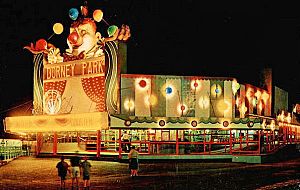
The Lehigh Valley is known historically for its production of steel, Portland cement and apparel. It had served as a major U.S. center of industrial manufacturing since the 1800s but this role had diminished significantly in the late 20th century and early 21st century as companies moved to offshore locations for these activities.
Once a formidable industrial and manufacturing powerhouse serving the United States and global economies, the nationwide decline of this industry in the late 20th century and early 2000s led the Lehigh Valley to shift its economic focus more towards financial services, health care, life sciences and technology and becoming a distribution hub for some of the largest U.S. markets due to its comparatively low cost of doing business and proximity to some of the nation's largest metropolitan areas and markets.
However, a recent movement to reestablish manufacturing activities in the U.S., driven by customer demand for American-made products, faster product delivery, increased overseas wages, and inflated costs and extended timeframes for shipping has led to a increases in the local manufacturing base. Several large companies from China and Germany have each invested tens of millions of dollars into establishing significant operations in the Lehigh Valley, which has generated thousands of new local jobs.
Largest employers
As of 2019, the Lehigh Valley's top five employers are: 1.) Lehigh Valley Health Network, 2.) St. Luke's Hospital and Health Network, 3.) Amazon, 4.) Lehigh Valley Physician Group, and 5.) Mack Trucks.
Business and economic environment
The Lehigh Valley is one of the fastest-growing and largest economies in Pennsylvania with a total GDP of US$43,800,000,000 ($43.8 billion) that saw a 5 percent increase between 2016 and 2017 alone driven by strong manufacturing, financial, health care, and professional services industry segments. It is centrally located in the Northeast Megalopolis with ease of access and close proximity to several of the largest markets, population centers, airports, terminals, railways and seaports in the United States including both the New York City and Philadelphia metropolitan areas. The Lehigh Valley is also situated within a one-day drive to more than one third of the total population of the United States and more than one half of the total population of Canada. The area has a lower cost of living, more affordable real estate, lower taxes, better access to institutions of higher education, and a larger and more affordable labor pool, however, than many other Northeastern US regions. These attributes and others, such as sizable investments in business development incentive programs and a friendlier regulatory environment, provide the area with an attractive business climate in comparison to surrounding areas.
Due in large part to the aforementioned comparably favorable business climate and mature business support programs, such as the state's Ben Franklin Technology Partners business incubator and investment fund, the Lehigh Valley has been very successful in luring established businesses as well as new startup companies from higher cost areas such as New York and New Jersey, bringing with them thousands of new jobs and significant new investments to the region. For example, according to Inc. Magazine, America's fastest growing cyber security company, 2nd fastest growing company in all of Pennsylvania, and 47th fastest growing private company in the nation overall in 2019, Netizen Corporation, was founded and is based in the Lehigh Valley. Large companies such as Amazon.com have also praised the region for its commitment to business support, infrastructure investment, and incentive programs, citing them as major reasons for their continuing expansions and increased hiring in the region and Allegiant Air, a low-cost budget airline, is opening a new flight base at the Lehigh Valley International Airport in February 2020, noting the area's rapid growth, lower costs of doing business, and proximity to popular destinations as significant factors in its decision to do so.
Other large national and international companies either based in the Lehigh Valley or with significant operations there include Broadcom Corporation (in Allentown), Avantor Performance Materials (Center Valley), Air Products and Chemicals (in Trexlertown), Crayola LLC (in Easton), Buckeye Partners (in Emmaus), Heidelberg Cement (in Fogelsville), Just Born (in Bethlehem, maker of the popular Peeps candies), Lutron Electronics (in Coopersburg), Mack Trucks (in Allentown), Martin Guitar (in Nazareth), Olympus Corporation USA (in Center Valley), OraSure Technologies (in Bethlehem), PPL Corporation (in Allentown), Rodale Press (in Emmaus), Wind Creek Bethlehem (in Bethlehem), Dun & Bradstreet (in Center Valley), Synchronoss Technologies (in Bethlehem), Victaulic (in Easton), and others.
Further reaffirming the area's advantageous business and economic environment, the Lehigh Valley was recognized by business publication Site Selection Magazine in 2014, 2017, 2018, and again in 2019 as being the second-best performing region of its size for economic development in the United States and the best performing region in the entire northeast. It was also ranked by Fortune in May 2015 as being amongst the top 10 best places in the U.S. to locate corporate finance and information technology operations for companies, such as call centers and IT support. Allentown, the region's largest city, was cited as a "national success story" in April 2016 by the Urban Land Institute for its downtown redevelopment and transformation that has resulted in US$1,000,000,000 ($1 billion) worth of new development projects there between 2015 and 2019 alone, one of only six communities nationwide to have achieved this distinction.
The Lehigh Valley is also one of the largest areas on the East Coast for the location of warehouses and distribution centers. Because of this, it is sometimes referred to as the nation's "second Inland Empire" for freight. Large national companies that own and operate warehouses and distribution centers in the Lehigh Valley include Amazon.com, B. Braun, Boston Beer Company (brewer of Samuel Adams brand beer), BMW, Bridgestone, FedEx SmartPost, FedEx Ground, Home Depot, J. C. Penney, Nestlé Purina, ShopRite, Stitch Fix, The Coca-Cola Company, Ocean Spray, Phillips Pet Food and Supplies, True Value, Uline, Zulily, and many others. Most of these warehouses and distribution centers are located along the U.S. Route 22, Interstate 78 and Interstate 476 corridors in the region which provide direct access to numerous major markets throughout the northeast and beyond.
Due to this direct access and proximity to major markets, FedEx Ground constructed their largest distribution hub in the country in the Lehigh Valley near the international airport. This new hub can process up to 45,000 packages per hour and currently employs over 2,000 people. By 2030, it will have a total size of 1,100,000 (1.1 million) square feet and employ over 3,000 people in total. It opened in September 2018 at a cost of $335 million to build. Furthermore, Amazon.com leverages the Lehigh Valley International Airport (LVIA) as one of only 11 locations in the country for their Amazon Air shipping service. LVIA was one of the first airports selected for the pilot concept of the Amazon Air program due to its close proximity to large population centers, cost-effectiveness, robust infrastructure, and comparative ease of use and access. This location now ships more merchandise, has more flights, and serves more people (over 75 million as of late 2016) for Amazon than any other facility in the country. Amazon and numerous other large companies continue to invest heavily in the region to better support the ever-increasing demand for efficient cargo transportation, driven in large part by the explosive growth of e-commerce and customer requirements for faster and more cost effective delivery of merchandise.
The Boston Beer Company operates its largest production brewery facility in the country in the Lehigh Valley (in Breinigsville), which produces more than 2/3rds of all Samuel Adams beer in the world. The company continues to upgrade and expand operations at this facility and has cited the location as central to the company's success. Additionally, Ocean Spray, a popular maker of juice drinks and other fruit products, produces 40 percent of its total national beverage volume at its Lehigh Valley plant in Breinigsville. Due to Pennsylvania's lack of an excise tax on cigars and the Lehigh Valley's close proximity to major markets, the region is also home to some of the United States' largest cigar distributors and retailers.
Retail shopping
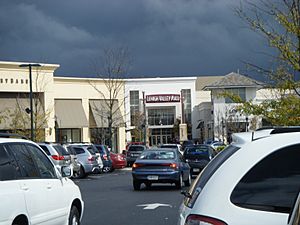
The Lehigh Valley is home to many retail establishments. The largest retail area of the Lehigh Valley is the Pennsylvania Route 145/MacArthur Road Corridor, just north of Allentown. It is anchored by the Lehigh Valley Mall and the Whitehall Mall.
Other malls in the region include Palmer Park Mall (in Easton), South Mall (in Allentown), and the Westgate Mall (in Bethlehem). In October 2006, a new Valley-based shopping mall, The Promenade Shops at Saucon Valley, was opened. Located off Route 309 in Upper Saucon Township, The Promenade is roughly half the size of the Lehigh Valley Mall, but features more upscale stores. In 2011, The Outlets at Sands Bethlehem (now The Outlets at Wind Creek Bethlehem) opened at the Sands Casino in Bethlehem, becoming the first outlet mall in the Lehigh Valley.
Yocco's Hot Dogs, the regionally-famous fast food establishment known for their hot dogs and cheesesteaks, maintains six locations, all of which are based in the Lehigh Valley. Its original restaurant, founded in 1922, is still located at its original center city Allentown location on West Liberty Street. The remaining five additional locations in the Lehigh Valley are located in west-side Allentown, east-side Allentown, Emmaus, Fogelsville, and Wescosville.
Awards and recognition
In 2014, 2017, 2018, 2019, and again in 2020, the Lehigh Valley was recognized by Site Selection Magazine as the one of the top five best-performing regions of its size (up to 1,000,000 residents) for economic development in the country and the best-performing region in the entire Northeastern United States. It was also ranked by Fortune in May 2015 as being among the top 10 best places in the U.S. to locate corporate finance and information technology operations, such as call centers and IT support. Allentown, the Lehigh Valley's largest city, was cited as a "national success story" in April 2016 by the Urban Land Institute for its downtown redevelopment and transformation that has resulted in US$1,000,000,000 ($1 billion) worth of new development projects there between 2015 and 2018, one of only six communities nationwide of any size to have achieved this distinction.
Sports
| Club | League | Sport | Venue | Established | Championships |
|---|---|---|---|---|---|
| Lehigh Valley IronPigs | IL | Baseball | Coca-Cola Park | 2008 | 0 |
| Lehigh Valley Phantoms | AHL | Ice hockey | PPL Center | 1996 | 2 |
| Lehigh Valley Steelhawks | NAL | Indoor football | PPL Center | 2011 | 0 |
| FC Sonic Lehigh Valley | NPSL | Soccer | Ulrich Sports Complex | 2009 | 1 (2012) |
| Lehigh Valley Rollergirls | WFTDA | Roller Derby | Hamburg Field House | 2006 | 0 |
American football
National Football League
From 1996 until 2012, the Lehigh Valley was the home of pre-season training camp for the NFL's Philadelphia Eagles, which was held each summer on the football fields of Lehigh University in Bethlehem. In 2013 with the hiring of new head coach Chip Kelly, the Eagles moved their training camp to the NovaCare Complex in Philadelphia.
College football

The Lehigh Valley is also home to a long-standing collegiate football rivalry between two local colleges, Lafayette College in Easton and Lehigh University in Bethlehem. The two teams have played each other 155 times since 1884, making it the longest uninterrupted rivalry in the history of college football.
Baseball
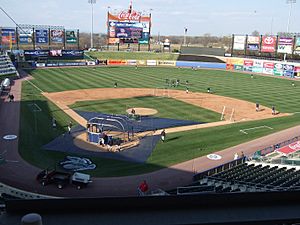
In early 2008, Coca-Cola Park, an 8,100-seat Minor League baseball stadium, opened in east-side Allentown. The stadium hosts the Lehigh Valley IronPigs, the Philadelphia Phillies' AAA-level International League franchise. The team previously played as the Ottawa Lynx (1993–2007). The club's move to the Lehigh Valley brought the franchise closer to Philadelphia and the Phillies' large eastern Pennsylvania fan base. The team's name is a reference to pig iron, which is used in steelmaking for which the Lehigh Valley area is known worldwide.
Groundbreaking ceremonies for Coca-Cola Park were held September 6, 2006, and construction was completed in December 2007. The stadium hosted its first game on March 30, 2008, when the Phillies major league team faced the IronPigs.
Gymnastics
Parkettes National Gymnastics Training Center, which has been the training ground for numerous Olympians and U.S. national gymnastics champions, is based in Allentown. In 2003, CNN aired a documentary on Parkettes, Achieving the Perfect 10, which depicted it as a hugely demanding and competitive training program.
High school athletics
The 12 largest high schools in the Lehigh Valley compete athletically in the Eastern Pennsylvania Conference, which has produced numerous professional and Olympic-level athletes. The conference's high school football, basketball, wrestling, and field hockey teams are often ranked among the best in the nation.
In USA Today's annual ranking of the nation's top high school sports teams, Liberty High School was ranked second in the Eastern United States in football in 2008 and 20th among all high schools nationally. Parkland High School was ranked fifth in the East in football in 2002 and 11th among all high schools nationally. Allentown Central Catholic High School was ranked seventh in girls' basketball in the East in both 2001–02 and 2002–03. In high school field hockey, Emmaus High School has won 33 consecutive East Penn Conference championships.
Multiple Eastern Pennsylvania Conference athletes have gone of to professional careers in Major League Baseball, the National Basketball Association, and the National Football League. An additional 14 Lehigh Valley high schools too small to compete in the East Penn Conference compete in the Colonial League.
Ice hockey
In March 2011, plans were announced for the creation of PPL Center, an 8,500-seat arena to be built in Allentown as the home for the Lehigh Valley Phantoms, the American Hockey League affiliate of the Philadelphia Flyers, and for other sporting and entertainment events. The PPL Center opened on September 10, 2014 and The Phantoms began play there starting with their 2014–15 season. The arena is located in downtown Allentown taking up the entire block between 7th and 8th Streets and Hamilton Boulevard and Linden Street.
Roller derby
Lehigh Valley Roller Derby (LVRG) is a Women's Flat Track Derby Association league based in the Lehigh Valley and its teams compete against national and international teams. The league now hosts home games at Bethlehem Municipal Ice Rink in Bethlehem.
Running events
The Lehigh Valley Health Network Via Marathon, which features a certified marathon, a five-person team relay, a 20-mile (32 km) training run and 5K walk is held annually in September. The 42.195-kilometre (26.219 mi) course follows the Lehigh River Canal Towpath from Allentown to Easton. The marathon came under scrutiny in 2015 when Mike Rossi achieved viral fame after allegedly cheating in the marathon to qualify for the Boston Marathon. In response, Via Marathon organizers added timing mats and video surveillance on-course.
Lehigh University's Paul Short Run is held annually at the Goodman Cross Country Course and participation has climbed to over 5,000 runners spread throughout 14 college and high school races. The Emmaus 5K race is held annually in mid-October, coinciding with Emmaus' annual Halloween parade.
Track cycling
The Lehigh Valley is home to the Valley Preferred Cycling Center, often called T-Town, which hosts UCI-sponsored events, regularly bringing athletes from all around the world to the Lehigh Valley and offering developmental programs producing many Olympic track cyclists.
Education
Colleges and universities
The Lehigh Valley is a center of post-secondary education, with several four-year colleges and universities. These include:
- Cedar Crest College (in Allentown)
- DeSales University (in Center Valley)
- Lafayette College (in Easton)
- Lehigh University (in Bethlehem)
- Moravian College (in Bethlehem)
- Muhlenberg College (in Allentown)
- Penn State Lehigh Valley (in Center Valley)
The Lehigh Valley is also home to two two-year colleges:
- Lehigh Carbon Community College (with campuses in Allentown, Carbon County and Schnecksville)
- Northampton Community College (with campuses in Bethlehem, Bethlehem Township and Monroe County)
High school education
The Lehigh Valley is the third most populous metropolitan region in Pennsylvania and served by numerous school districts, public and private high schools, middle schools, and elementary schools, including:
|
|
The largest Lehigh Valley high schools (18 in all) compete athletically in the East Penn Conference. Smaller Lehigh Valley high schools compete in the Colonial League. In addition to its exceptional high school athletic teams, the Lehigh Valley is known nationally for its excellent math team, the Lehigh Valley Fire, which has won the American Regions Mathematics League competition in 2005, 2009, 2010, and 2011 and placed in the top 10 teams nationally every year since.
Miscellaneous education
The nearest weekend school for Japanese national children and children of Japanese heritage, known as Hoshū jugyō kōs, is the Japanese Language School of Philadelphia (JLSP, フィラデルフィア日本語補習授業校 Firaderufia Nihongo Hoshū Jugyō Kō) located in Wynnewood, Pennsylvania. The government of Japan funds this school through its Ministry of Education, Culture, Sports, Science and Technology.
Notable people from the Lehigh Valley
The Lehigh Valley is the birthplace or home to a number of famous Americans, including:
- Mario Andretti, former professional race car driver
- Michael Andretti, professional racing team owner and race car driver
- Saquon Barkley, professional football player, New York Giants
- Chuck Bednarik, former professional football player, Philadelphia Eagles, 1967 Pro Football Hall of Fame inductee
- Stephen Vincent Benét, poet and novelist
- Sabrina Carpenter, actress and singer
- Leon Carr, former Broadway songwriter and composer
- Jack Coleman, actor, NBC's Heroes
- Michaela Conlin, actress, Angela Montenegro character on Fox's Bones
- H.D., poet and novelist
- Jimmy DeGrasso, heavy metal drummer, Alice Cooper band and former drummer, Megadeth and Ratt
- Dane DeHaan, television and film actor, In Treatment and Chronicle
- Charlie Dent, former member of Congress
- Keith Dorney, former professional football player, Detroit Lions
- Jonathan Frakes, actor, Star Trek: The Next Generation
- Mike Hartenstine, former professional football player, Chicago Bears and Minnesota Vikings
- Bob Heffner, former professional baseball player, Boston Red Sox, California Angels and Cleveland Indians
- Tim Heidecker, actor, comedian, musician, Tim and Eric Awesome Show, Great Job! and Decker
- Larry Holmes, former boxing heavyweight champion
- Todd Howard, video game designer, Fallout and The Elder Scrolls
- Lee Iacocca, former president and chief executive officer, Chrysler Corporation
- Keith Jarrett, jazz musician
- Michael Johns, health care executive, former White House presidential speechwriter
- Dwayne Johnson ("The Rock"), actor, former professional wrestler
- Billy Kidman, former professional wrestler
- Daniel Dae Kim, film and television actor, ABC's Lost
- Steve Kimock, rock musician
- John Kline, former member of Congress
- Brian Knobbs, former professional wrestler
- Dan Koppen, former professional football player, Denver Broncos and New England Patriots
- Carson Kressley, fashion consultant, Bravo's Queer Eye
- Varvara Lepchenko, professional tennis player
- Jonathan Linton, former professional football player, Buffalo Bills
- William Marchant, playwright and screenwriter
- Kristen Maloney, 2000 Olympian gymnast
- Ed McCaffrey, former professional football player, Denver Broncos, New York Giants, and San Francisco 49ers
- Kate Micucci, actress, comedian, singer-songwriter
- Matt Millen, former professional football player, Oakland Raiders, San Francisco 49ers and Washington Redskins, former president and general manager, Detroit Lions
- Lara Jill Miller, actress and voice actress, NBC's Gimme a Break! and Nickelodeon's The Amanda Show
- Marty Nothstein, former Olympic gold medal winner, track cycling
- Andre Reed, former professional football player, Buffalo Bills and Washington Redskins, 2014 Pro Football Hall of Fame inductee
- Ian Riccaboni author, sports broadcaster for Ring of Honor professional wrestling
- Daniel Roebuck, actor, Matlock, Lost, Glee and Grimm
- Jimmie Schaffer, former professional baseball player, Chicago Cubs, Chicago White Sox, Cincinnati Reds, New York Mets, Philadelphia Phillies and St. Louis Cardinals
- Brian Schneider, former professional baseball player, Miami Marlins, New York Mets, Philadelphia Phillies and Washington Nationals
- Amanda Seyfried, model and film and television actress, The CW's Veronica Mars and HBO's Big Love
- Shadow Gallery, progressive metal band
- Sheetal Sheth, actress, Looking for Comedy in the Muslim World
- Curt Simmons, former professional baseball player, California Angels, Chicago Cubs, Philadelphia Phillies and St. Louis Cardinals
- Dana Snyder, voice actor, Adult Swim's Aqua Teen Hunger Force
- Christine Taylor, actress and wife of actor Ben Stiller
- Jonathan Taylor Thomas, actor, ABC's Home Improvement
- Boris Vallejo, science fiction and fantasy fiction artist
- Bobby Weaver, 1984 Olympic gold medal winner, wrestling
- Lauren Weisberger, author, The Devil Wears Prada
- Cindy Werley, 1996 Olympic field hockey player
- Jordan White, rock musician
- David Zinczenko, founder and chief executive officer, Galvanized, author Eat This, Not That
- David Zippel, Tony-award-winning lyricist, City of Angels
Images for kids
-
Shelter House in Emmaus, constructed in 1734 by Pennsylvania German settlers, is believed to be the Lehigh Valley's oldest continuously occupied building structure
-
Bethlehem Steel in Bethlehem was one of the world's leading steel manufacturers for most of the 19th and 20th century and played an influential role in building many of the nation's most prominent buildings and bridges and in manufacturing ships and military equipment that contributed to the rise of America's defense strength
-
Allentown, the largest city in the Lehigh Valley and third largest city in Pennsylvania, May 2010
-
The Easton–Phillipsburg Toll Bridge, connecting Easton, Pennsylvania and Phillipsburg, New Jersey in the Lehigh Valley, October 2009
-
Christmas lights at Lehigh Valley Zoo in Schnecksville, December 2020
-
The city skyline of center city Allentown, Christmas 2017
-
The now dormant but still standing steel stacks of Bethlehem Steel in Bethlehem. Once the second largest steel manufacturer in the nation, Bethlehem Steel ceased most of its operations in 1982, declared bankruptcy in 2001, and was dissolved in 2003
-
The global headquarters of Air Products in Allentown, March 2014
-
Lehigh Valley Hospital–Cedar Crest on Cedar Crest Boulevard in Allentown, the largest current employer in the Lehigh Valley and third largest hospital in Pennsylvania with 877 beds and 46 operating rooms, July 2008
-
The campus of Muhlenberg College in Allentown, March 2014
-
Allen High School, one of Allentown's two large public high schools, July 2008
-
Liberty High School in Bethlehem, February 2020
-
PPL Center in Allentown, the home arena of the Lehigh Valley Phantoms of the American Hockey League and the primary development team of the Philadelphia Flyers
-
Musikfest, the nation's largest free music festival, held annually in Bethlehem, August 2019
-
The ski lodge at Bear Creek Mountain Resort in Macungie, January 2012



